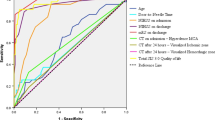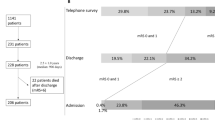Abstract
Introduction
The use of intravenous thrombolysis with alteplase for ischemic stroke in Europe is restricted to subjects aged <80 years. Recent studies have reported the efficacy and safety of alteplase in older patients. However, data concerning the quality of life (QOL) of these elderly subjects are sparse.
Objectives
The aim of this study was to compare the QOL of patients aged ≥80 years with that of patients aged <80 years at 3 months after thrombolysis.
Method
This was a prospective study comprising French-speaking patients aged >18 years treated using thrombolytic therapy for ischemic stroke at the Hospital of Tours (Tours, France) between June 2012 and January 2013. QOL was assessed using the Stroke Impact Scale (SIS). The presence of mood disorders or cognitive impairments was also assessed.
Results
QOL was evaluated for 62 subjects among the 83 enrolled patients who received thrombolytic treatment; 21 patients were aged >80 years. Concerning scores on the SIS, using a multivariate analysis, only the memory and thinking score was significantly and negatively associated with the elderly population [odds ratio (OR) 0.036, 95 % confidence interval (CI) 0.004–0.339; p = 0.004]. No significant difference was observed among all the other QOL scores. Neurological recovery and functional status did not differ between the two groups.
Conclusion
QOL after intravenous thrombolysis in the elderly population was comparable to that of younger subjects. Despite its small sample size, this study showed promising results in favor of intravenous thrombolysis in the elderly population and highlighted the importance of systematic screening for post-stroke cognitive impairment, particularly in this population.

Similar content being viewed by others
References
Feigin VL, Lawes CMM, Bennett DA, et al. Stroke epidemiology: a review of population-based studies of incidence, prevalence, and case-fatality in the late 20th century. Lancet Neurol. 2003;2:43–53.
Béjot Y, Rouaud O, Jacquin A, et al. Stroke in the very old: incidence, risk factors, clinical features, outcomes and access to resources—a 22-year population-based study. Cerebrovasc Dis. 2010;29:111–21.
Saposnik G, Cote R, Phillips S, et al. Stroke outcome in those over 80: a multicenter cohort study across Canada. Stroke. 2008;39:2310–7.
Tissue plasminogen activator for acute ischemic stroke. The National Institute of Neurological Disorders and Stroke rt-PA Stroke Study Group. N Engl J Med. 1995;333:1581–7.
Berrouschot J, Röther J, Glahn J, et al. Outcome and severe hemorrhagic complications of intravenous thrombolysis with tissue plasminogen activator in very old (> or =80 years) stroke patients. Stroke. 2005;36:2421–5.
IST-3 collaborative group, Sandercock P, Wardlaw JM, et al. The benefits and harms of intravenous thrombolysis with recombinant tissue plasminogen activator within 6 h of acute ischaemic stroke [the third international stroke trial (IST-3)]: a randomised controlled trial. Lancet. 2012;379:2352–63.
IST-3 collaborative group. Effect of thrombolysis with alteplase within 6 h of acute ischaemic stroke on long-term outcomes [the third International Stroke Trial (IST-3)]: 18-month follow-up of a randomised controlled trial. Lancet Neurol. 2013;12:768–76.
Kissela B. The value of quality of life research in stroke. Stroke. 2006;37:1958–9.
Anderson C. Thrombolysis with alteplase after stroke: extending outcomes. Lancet Neurol. 2013;12:731–2.
Morris JH, van Wijck F, Joice S, et al. Predicting health related quality of life 6 months after stroke: the role of anxiety and upper limb dysfunction. Disabil Rehabil. 2013;35:291–9.
Carod-Artal J, Egido JA, González JL, et al. Quality of life among stroke survivors evaluated 1 year after stroke: experience of a stroke unit. Stroke. 2000;31:2995–3000.
Carod-Artal FJ, Egido JA. Quality of life after stroke: the importance of a good recovery. Cerebrovasc Dis. 2009;27(Suppl 1):204–14.
Hackett ML, Anderson CS. Predictors of depression after stroke: a systematic review of observational studies. Stroke. 2005;36:2296–301.
Dhamoon MS, Moon YP, Paik MC, et al. Quality of life declines after first ischemic stroke. The Northern Manhattan Study. Neurology. 2010;75:328–34.
Hacke W, Kaste M, Bluhmki E, et al. Thrombolysis with alteplase 3 to 4.5 hours after acute ischemic stroke. N Engl J Med. 2008;359:1317–29.
Hacke W, Donnan G, Fieschi C, et al. Association of outcome with early stroke treatment: pooled analysis of ATLANTIS, ECASS, and NINDS rt-PA stroke trials. Lancet. 2004;363:768–74.
Boulouis G, Dumont F, Cordonnier C, et al. Intravenous thrombolysis for acute cerebral ischaemia in old stroke patients ≥80 years of age. J Neurol. 2012;259:1461–7.
Duncan PW, Wallace D, Lai SM, et al. The stroke impact scale version 2.0. Evaluation of reliability, validity, and sensitivity to change. Stroke. 1999;30:2131–40.
Carod-Artal FJ, Ferreira Coral L, Stieven Trizotto D, et al. Self- and proxy-report agreement on the Stroke Impact Scale. Stroke. 2009;40:3308–14.
Abubakar SA, Isezuo SA. Health related quality of life of stroke survivors: experience of a stroke unit. Int J Biomed Sci. 2012;8:183–7.
Sheehan DV, Lecrubier Y, Sheehan KH, et al. The Mini-International Neuropsychiatric Interview (M.I.N.I.): the development and validation of a structured diagnostic psychiatric interview for DSM-IV and ICD-10. J Clin Psychiatry. 1998;59(Suppl 20):22–33.
Sagen U, Vik TG, Moum T, et al. Screening for anxiety and depression after stroke: comparison of the hospital anxiety and depression scale and the Montgomery and Asberg depression rating scale. J Psychosom Res. 2009;67:325–32.
Maier W, Buller R, Philipp M, et al. The Hamilton Anxiety Scale: reliability, validity and sensitivity to change in anxiety and depressive disorders. J Affect Disord. 1988;14:61–8.
Kalafat M, Hugonot-Diener L, Poitrenaud J. Standardisation et étalonnage français du “Mini Mental State”(MMS) version GRECO. Rev Neuropsychol. 2003;13:209–36.
Folstein MF, Folstein SE, McHugh PR. ‘Mini-mental state’. A practical method for grading the cognitive state of patients for the clinician. J Psychiatr Res. 1975;12:189–98.
Nasreddine ZS, Phillips NA, Bédirian V, et al. The Montreal Cognitive Assessment, MoCA: a brief screening tool for mild cognitive impairment. J Am Geriatr Soc. 2005;53:695–9.
Béland R, Lecours AR. The mt-86 β aphasia battery: a subset of normative data in relation to age and level of school education. Aphasiology. 1990;4:439–62.
Mishra NK, Diener H-C, Lyden PD, et al. Influence of age on outcome from thrombolysis in acute stroke: a controlled comparison in patients from the Virtual International Stroke Trials Archive (VISTA). Stroke. 2010;41:2840–8.
Mishra NK, Ahmed N, Andersen G, et al. Thrombolysis in very elderly people: controlled comparison of SITS International Stroke Thrombolysis Registry and Virtual International Stroke Trials Archive. BMJ. 2010;341:c6046.
Wardlaw JM, Murray V, Berge E, et al. Recombinant tissue plasminogen activator for acute ischaemic stroke: an updated systematic review and meta-analysis. Lancet. 2012;379:2364–72.
Cenciarelli S, Mazzoli T, Ricci S. Ischaemic stroke and thrombolysis: ask the onset time, not the age! Intern Emerg Med. 2013;8:99–100.
Engelter ST, Bonati LH, Lyrer PA. Intravenous thrombolysis in stroke patients of > or = 80 versus <80 years of age–a systematic review across cohort studies. Age Ageing. 2006;35:572–80.
Schwab-Malek S, Vatankhah B, Bogdahn U, et al. Depressive symptoms and quality of life after thrombolysis in stroke: the TEMPiS study. J Neurol. 2010;257:1848–54.
De Weerd L, Luijckx G-JR, Groenier KH, et al. Quality of life of elderly ischaemic stroke patients one year after thrombolytic therapy. A comparison between patients with and without thrombolytic therapy. BMC Neurol. 2012;12:61.
Murao K, Leys D, Jacquin A, et al. Thrombolytic therapy for stroke in patients with preexisting cognitive impairment. Neurology. 2014;82(23):2048–54.
Carod-Artal FJ, Trizotto DS, Coral LF, et al. Determinants of quality of life in Brazilian stroke survivors. J Neurol Sci. 2009;284:63–8.
Jönsson A-C, Lindgren I, Hallström B, et al. Determinants of quality of life in stroke survivors and their informal caregivers. Stroke. 2005;36:803–8.
Derex L, Nighoghossian N. Thrombolysis, stroke-unit admission and early rehabilitation in elderly patients. Nat Rev Neurol. 2009;5:506–11.
Jiménez Caballero PE, López Espuela F, Portilla Cuenca JC, et al. Charlson comorbidity index in ischemic stroke and intracerebral hemorrhage as predictor of mortality and functional outcome after 6 months. J Stroke Cerebrovasc Dis. 2013;22:e214–8.
Author information
Authors and Affiliations
Corresponding author
Ethics declarations
Funding
The authors declare that they received no funding for this study.
Conflict of interest
The authors declare that they have no conflicts of interest.
Rights and permissions
About this article
Cite this article
Diard-Detoeuf, C., Debiais, S., Imbert, M. et al. Quality of Life After Off-Label Thrombolysis for Ischemic Stroke in Elderly Patients. Drugs Aging 32, 917–926 (2015). https://doi.org/10.1007/s40266-015-0307-4
Published:
Issue Date:
DOI: https://doi.org/10.1007/s40266-015-0307-4




